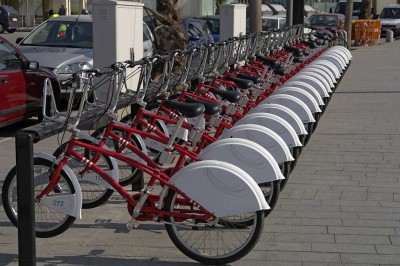
The other day, I came across an article about bike share schemes in the U.S. The author made some predictions based upon the assumption that since Boston was a small city whose residents could walk to work in nice weather, it would be easier to implement a bike share here than in larger cities. The author further drew an analogy between Boston’s small size and an “affinity” for bicycle commuters.
I couldn’t see a direct connection between smallness and an affinity for bicycle commuters. And, I also wasn’t certain what Bostonians walking to work or bicycle commuters had to do with a bike share. But after reading this article, I began to think about Boston’s new bike share program and wondered exactly who would be using it and why.
Most of what I’ve heard from the “experts” assumes that either tourists or Bostonians working in Boston will utilize the bike share program. In both cases, using a bike would replace walking around the city.
As I thought about how a bike share could be used, it occurred to me that we shouldn’t limit ourselves in thinking about who will use a bike share program or how. Predictions become self-fulfilling prophecies and their limitations can cause a fledgling idea to falter.
I tried to imagine how, as a cyclist, I might use the bike share. I definitely would not use it to travel longer distances because I already own a bike which is better suited for long distance riding than the bike share bikes. And, my situation doesn’t warrant quick trips around the city.
Still, as a cyclist who occasionally uses public transportation or a car, there are times when being able to rent a bike for short trips would be useful. For instance, there are places in Boston, and surrounding communities, which are not directly accessible by public transportation. It’s possible to get there by changing buses or trains, but not without a long trip. Some of these places are also unfriendly to cars because parking is scarce and expensive.
If the bike share stations were positioned correctly – for the trip in question – it would be possible to travel places not directly served by public transportation in a fraction of the time.
In addition, some places are not safe for locking a bike outdoors for an extended period of time. Using the bike share would offer the best of both worlds. It would be possible to ride to a destination and leave the bike at a station, without having to worry about having your own bike stolen.
Unlike the author of the above-mentioned article, who envisions primarily workers within the city using the bike share, I can see a bike share as an option for public transportation users who live just outside of Boston. With strategically placed stations in surrounding towns, commuters could ride into work and either take public transportation, get a ride, or use the bike share to return home. This might appeal to people with unpredictable schedules who need more flexibility.
Outside of the situations already mentioned, cyclists probably won’t have as much use for a bike share as walkers, public transportation users and drivers. Someone who typically commutes by bike has little need for renting a bike on an ongoing basis.
So the question remains: will Boston’s bike share primarily be used by Bostonians and tourists who want to replace walking with a faster method of traveling from one place to another? Or will it replace driving by encouraging people to use a healthier, more environmentally friendly mode of transportation?
Of the two, walkers are more likely to be attracted to the idea of utilizing bikes to shorten travel time. Even though the bike share is touted as a means of alleviating traffic congestion in the city, getting drivers out of their cars will be a challenge. Only economic considerations such as high gas prices or higher tolls are likely to motivate them to change their ways.
Putting opposition and lack of cooperation from Boston’s anti-bicycle faction aside, the program’s success will depend upon residents making the bike share a permanent part of their lives. With a little imagination, most people who are willing and able to ride a bike should be able to think of times when hopping on a bike to get somewhere would make their lives easier. In any event, the bike share will be an enlightening experiment on whether bikes can be incorporated into American society.



